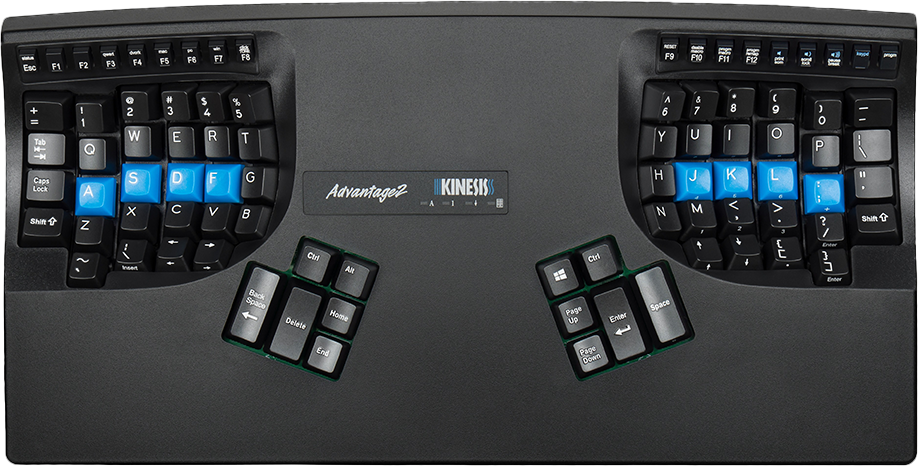Ergonomics Recommendations
(Epistemic status: try things!)
If you’re typing a lot, you may encounter (as I did) repetitive strain injuries. Mostly these appear to be caused by bad form. Unfortunately, traditional keyboards are not optimized for ergonomic form, but you can easily buy yourself a new keyboard that is.
Here’s the Kinesis:

It’s got all the keys you’re used to, but they’re aligned in vertical columns (instead of offset, like a normal keyboard). And wait, what’s that on the thumbs? Not just space bars, but all sorts of modifiers, backspace, delete, and some navigation keys. (Note: Kinesis also makes a few other keyboards but I’m only referring to the Kinesis Advantage Contoured.)
This is what I use on a daily basis. I don’t type all the time on it – I still use my laptop keyboard sometimes, but roughly 75% of my typing is on this keyboard. I’ve had a Kinesis for roughly 14 years and it’s probably the one thing that’s added more value to my life than any other, in terms of pain reduction and comfort each day.
I think a lot of people who type intensively end up with some kind of minor RSI. It’s flared up in various forms throughout the years – never been truly debilitating, but I remember in high school having serious wrist issues, but since then my pinkies have been the centers of pain when it flares up. But it only flares up when I type a lot on another keyboard, because the Kinesis is very effective at helping reduce this pain.
Why is the Kinesis so good? Let me count the ways…
- Wrists stay straight in front of you at shoulder width, instead of bent
- Fingers move straight up and down to reach different rows, instead of side-to-side
- A relatively light touch on the key is enough to press it, so less strain on muscles and tendons
- Pinkies are far healthier: On normal keyboards, the pinkies are usually used to “chord” – hold Ctrl/Shift while pressing other keys – as well as having a ton of random bits of punctuation on pinkies. On the Kinesis, you use your thumb for the chords, and the punctuation is moved to a 2nd bottom row below zxcvb so it spreads out that work across all fingers.
- Key travel is very well optimized to avoid damage to your fingers: the Kinesis has a long key travel distance, the key activates about halfway “pressed”, and the keyboard can be set to make a little electronic “click” sound when it activates. The combination of these three things means you can optimize your typing to avoid your fingers slamming the keys against the bottom of the keyboard. I do still contact the bottom when I type, but I am already decelerating by that point and so there’s less continued “shock” on my fingers.
You can get it for just over $300 on Amazon as of this writing.
Beyond a keyboard, there are other things to try for ergonomics, which have helped me:
- Install Workrave (Linux) or AntiRSI (Mac). Both these tools work similarly – they track when you’re actually actively using your computer and remind you to take breaks. Short “micro breaks” are supposed to pretty important and helpful when fighting RSI. I assume there is one for Windows also.
- Get an external monitor and mount it on an adjustable arm. Wirecutter has some recs. These things clamp to the back of your desk and hold up a monitor at any height you wish. Surprisingly helpful for viewing angle, much better than stacking books!